C语言函数大全--f开头的函数(上)
原创C语言函数大全--f开头的函数(上)
原创

总览
函数声明 | 函数功能 |
|---|---|
| 返回 x 的绝对值(double) |
| 返回 x 的绝对值(float) |
| 返回 x 的绝对值(long double) |
| 关闭一个文件流 |
| 关闭除标准流(stdin、stdout、stderr、stdprn、stdaux)之外的所有打开的流,刷新所有的流缓冲区,并返回关闭的流数。 |
| 把一个双精度浮点数转换为字符串 |
| 计算 x 和 y 之间的正差值 (double) |
| 计算 x 和 y 之间的正差值 (float) |
| 计算 x 和 y 之间的正差值 (long double) |
| 将文件描述符和文件流相关联 |
| 检测流上的文件结束符。如果文件结束,则返回非0值,否则返回0 |
| 检测流上的错误【返回0,表示未出错;返回非零值,表示出错。】 |
| 清除读写缓冲区,并将缓冲区内的数据写回参数stream指向的文件中。 |
| 从流中读取字符 |
| 从流中读取字符 |
| 依据当前文件的句柄,获取当前访问指针位置信息 |
| 从指定的流中读取数据,每次读取一行 |
| 获取文件的长度 |
| 获取参数stream指定的文件流所使用的文件描述符 |
| 画出并填充一椭圆 |
| 画并填充一个多边形 |
| 搜索与指定的文件名称匹配的第一个文件,若成功则返回第一个文件的文件描述符,否则返回-1L。 |
| 搜索与_findfirst函数提供的文件名称匹配的下一个实例,若成功则返回0,否则返回-1 |
| 检查 x 是无穷大值还是NaN 值(double)。如果是无穷大值或NaN值,返回 0;否则返回 1。 |
| 检查 x 是无穷大值还是NaN 值(float)。如果是无穷大值或NaN值,返回 0;否则返回 1。 |
| 填充一个有界区域 |
1. fabs,fabsf,fabsl
1.1 函数说明
函数声明 | 函数功能 |
|---|---|
| 返回 x 的绝对值(double) |
| 返回 x 的绝对值(float) |
| 返回 x 的绝对值(long double) |
1.2 演示示例
#include <stdio.h>
#include <math.h>
int main(void)
{
double result, x = -4.5;
result = fabs(x); // 取绝对值
float resultf, xf = -3.5;
resultf = fabsf(xf);
long double resultL, xL = -2.5;
resultL = fabsl(xL);
printf("The absolute value of %lf is %lf\n", x, result);
printf("The absolute value of %f is %f\n", xf, resultf);
printf("The absolute value of %Lf is %Lf\n", xL, resultL);
return 0;
}1.3 运行结果
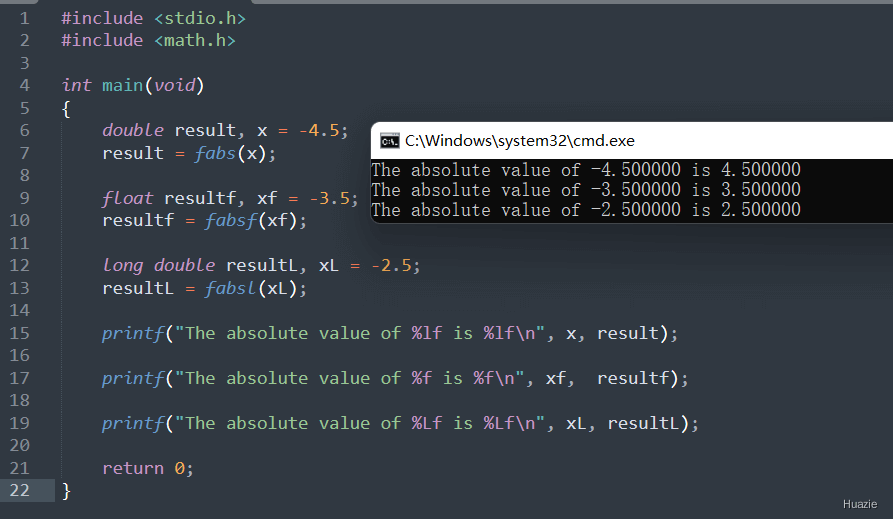
2. fclose
2.1 函数说明
函数声明 | 函数功能 |
|---|---|
| 关闭一个文件流 |
2.2 演示示例
#include <string.h>
#include <stdio.h>
int main(void)
{
FILE *fp;
char buf[30] = "Hello, Huazie 123456789";
fp = fopen("temp.txt", "w");
printf("temp.txt is created and opened\n");
fwrite(&buf, strlen(buf), 1, fp);
printf("temp.txt is writed\n");
fclose(fp);
printf("temp.txt is closed");
return 0;
}2.3 运行结果
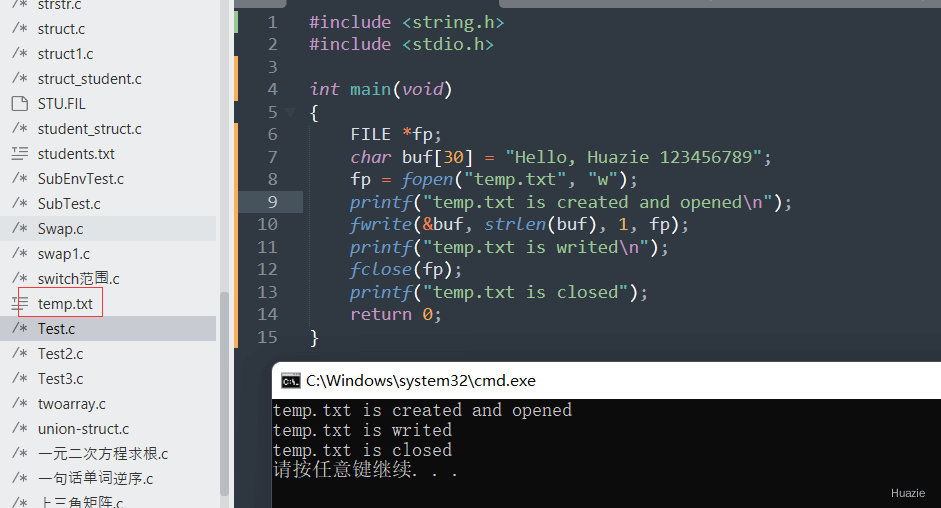

3. fcloseall
3.1 函数说明
函数声明 | 函数功能 |
|---|---|
| 关闭除标准流(stdin、stdout、stderr、stdprn、stdaux)之外的所有打开的流,刷新所有的流缓冲区,并返回关闭的流数。 |
3.2 演示示例
#include <stdio.h>
#define fcloseall() _fcloseall();
int main()
{
int streams_closed;
fopen("temp.one", "w");
fopen("temp.two", "w");
// 关闭打开流
streams_closed = fcloseall();
if (streams_closed == EOF)
perror("Error");
else
printf("%d streams were closed.\n", streams_closed);
return 0;
}3.3 运行结果

4. fcvt
4.1 函数说明
函数声明 | 函数功能 |
|---|---|
| 把一个双精度浮点数转换为字符串 |
- value: 要转换的双精度浮点数,输入参数
- ndigit: 取小数的位数,输入参数
- decpt: 表示小数点的位置,输出参数
- sign: 表示value的符号,0为正数,1为负数,输出参数
4.2 演示示例
#include <stdlib.h>
#include <stdio.h>
#include <conio.h>
int main()
{
char *string;
double value;
int decpt, sign;
int ndigit = 10;
value = 9.876;
string = fcvt(value, ndigit, &decpt, &sign);
printf("string = %-18s decpt = %d sign = %d value = %lf\n", string, decpt, sign, value);
value = -123.45;
ndigit= 15;
string = fcvt(value, ndigit, &decpt, &sign);
printf("string = %-18s decpt = %d sign = %d value = %lf\n", string, decpt, sign, value);
value = 0.6789e5; /* 科学记数法 scientific notation */
ndigit = 5;
string = fcvt(value, ndigit, &decpt, &sign);
printf("string = %-18s decpt = %d sign = %d value = %lf\n", string, decpt, sign, value);
return 0;
}4.3 运行结果
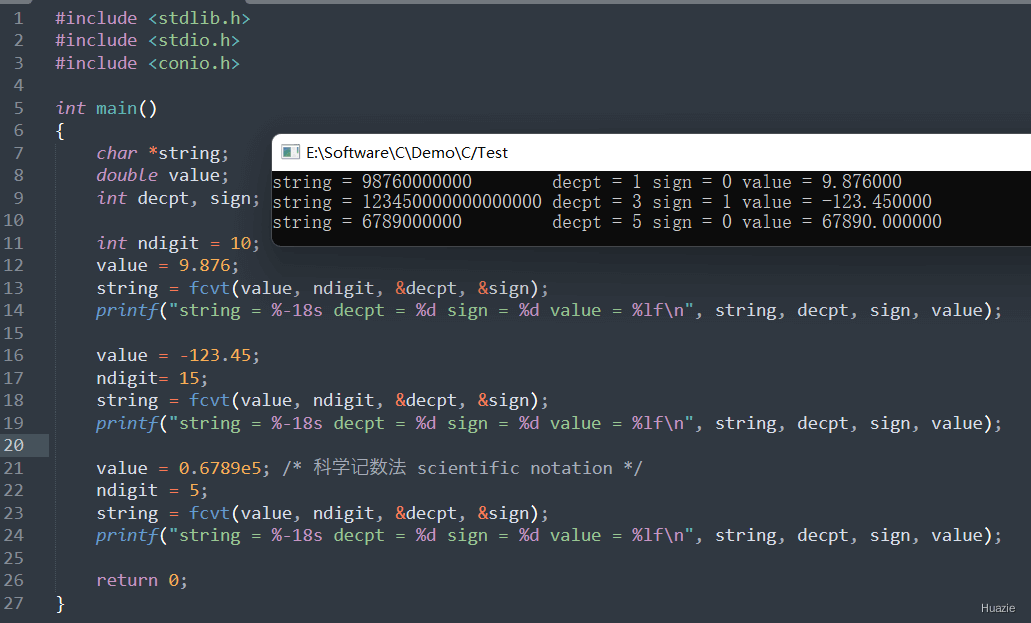
5. fdim,fdimf,fdiml
5.1 函数说明
函数声明 | 函数功能 |
|---|---|
| 计算 x 和 y 之间的正差值 (double) |
| 计算 x 和 y 之间的正差值 (float) |
| 计算 x 和 y 之间的正差值 (long double) |
5.2 演示示例
#include <stdio.h>
#include <math.h>
int main() {
double x = 5.000011;
double y = 3.000041;
double result_d = fdim(x, y);
float xf = 5.000011f;
float yf = 3.000031f;
float result_f = fdimf(xf, yf);
long double xLD = 5.000011L;
long double yLD = 3.000021L;
long double result_ld = fdiml(xLD, yLD);
printf("fdim(%.6lf, %.6lf) = %.6lf\n", x, y, result_d);
printf("fdimf(%.6f, %.6f) = %.6f\n", xf, yf, result_f);
printf("fdiml(%.6Lf, %Lf) = %.6Lf\n", xLD, yLD, result_ld);
return 0;
}5.3 运行结果

6. fdopen
6.1 函数说明
函数声明 | 函数功能 |
|---|---|
| 将文件描述符和文件流相关联 |
6.2 演示示例
#include <sys\stat.h>
#include <stdio.h>
#include <fcntl.h>
#include <io.h>
int main(void)
{
int handle;
FILE *stream;
// 打开 temp.txt 文件
handle = open("temp.txt", O_CREAT | O_RDWR, S_IREAD | S_IWRITE);
// 将文件描述符和文件流关联
stream = fdopen(handle, "w");
if (stream == NULL)
printf("fdopen failed\n");
else
{
fprintf(stream, "%s:%d\n", "Hello world", 123);
fclose(stream);
}
return 0;
}6.3 运行结果

7. feof
7.1 函数说明
函数声明 | 函数功能 |
|---|---|
| 检测流上的文件结束符。如果文件结束,则返回非0值,否则返回0 |
7.2 演示示例
#include <stdio.h>
int main(void)
{
FILE *stream;
// 以读取模式,打开文件 temp.txt
stream = fopen("temp.txt", "r");
// 检查是否文件结束【0:未结束 非0:结束】
while (!feof(stream))
printf("%c", fgetc(stream));
fclose(stream);
return 0;
}7.3 运行结果
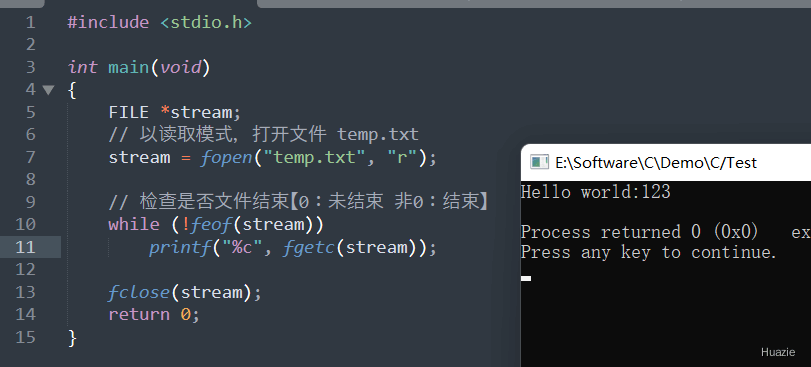
8. ferror
8.1 函数说明
函数声明 | 函数功能 |
|---|---|
| 检测流上的错误【返回0,表示未出错;返回非零值,表示出错。】 |
8.2 演示示例
#include <stdio.h>
int main(void)
{
FILE *stream;
// 以写模式打开文件STU.FIL
stream = fopen("STU.FIL", "w");
// 通过尝试读取来强制出现错误条件
(void) getc(stream);
// 检测流上的错误【返回0,表示未出错;返回非零值,表示出错。】
if (ferror(stream))
{
printf("Error reading from STU.FIL\n");
// 重置错误和EOF标志
clearerr(stream);
}
fclose(stream);
return 0;
}8.3 运行结果
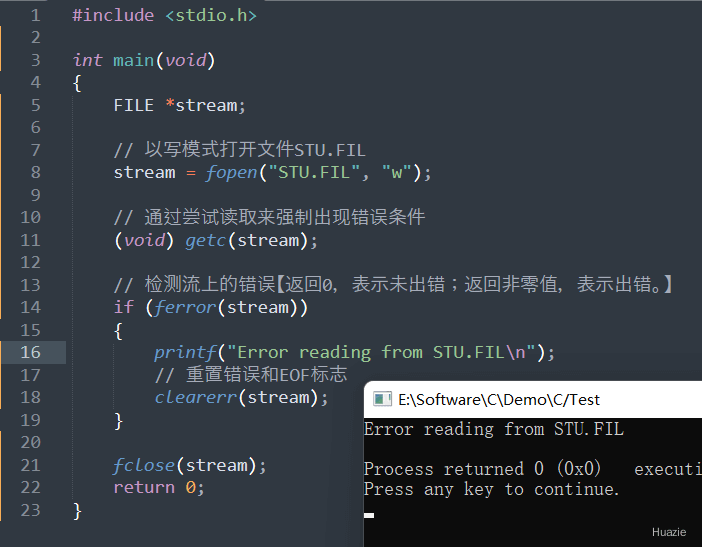
9. fflush
9.1 函数说明
函数声明 | 函数功能 |
|---|---|
| 清除读写缓冲区,并将缓冲区内的数据写回参数stream指向的文件中。 |
9.2 演示示例
#include <string.h>
#include <stdio.h>
#include <conio.h>
#include <io.h>
void flush(FILE *stream);
int main(void)
{
FILE *stream;
char msg[] = "This is a test";
stream = fopen("STU.FIL", "w");
fwrite(msg, strlen(msg), 1, stream);
printf("Press any key to flush STU.FIL:");
getchar();
// 将数据刷新到 STU.FIL 中而不关闭它
flush(stream);
printf("\nFile was flushed, Press any key to quit:");
getchar();
return 0;
}
void flush(FILE *stream)
{
int duphandle;
// flush the stream's internal buffer
fflush(stream);
// make a duplicate file handle
duphandle = dup(fileno(stream));
// close the duplicate handle to flush the DOS buffer
close(duphandle);
}9.3 运行结果
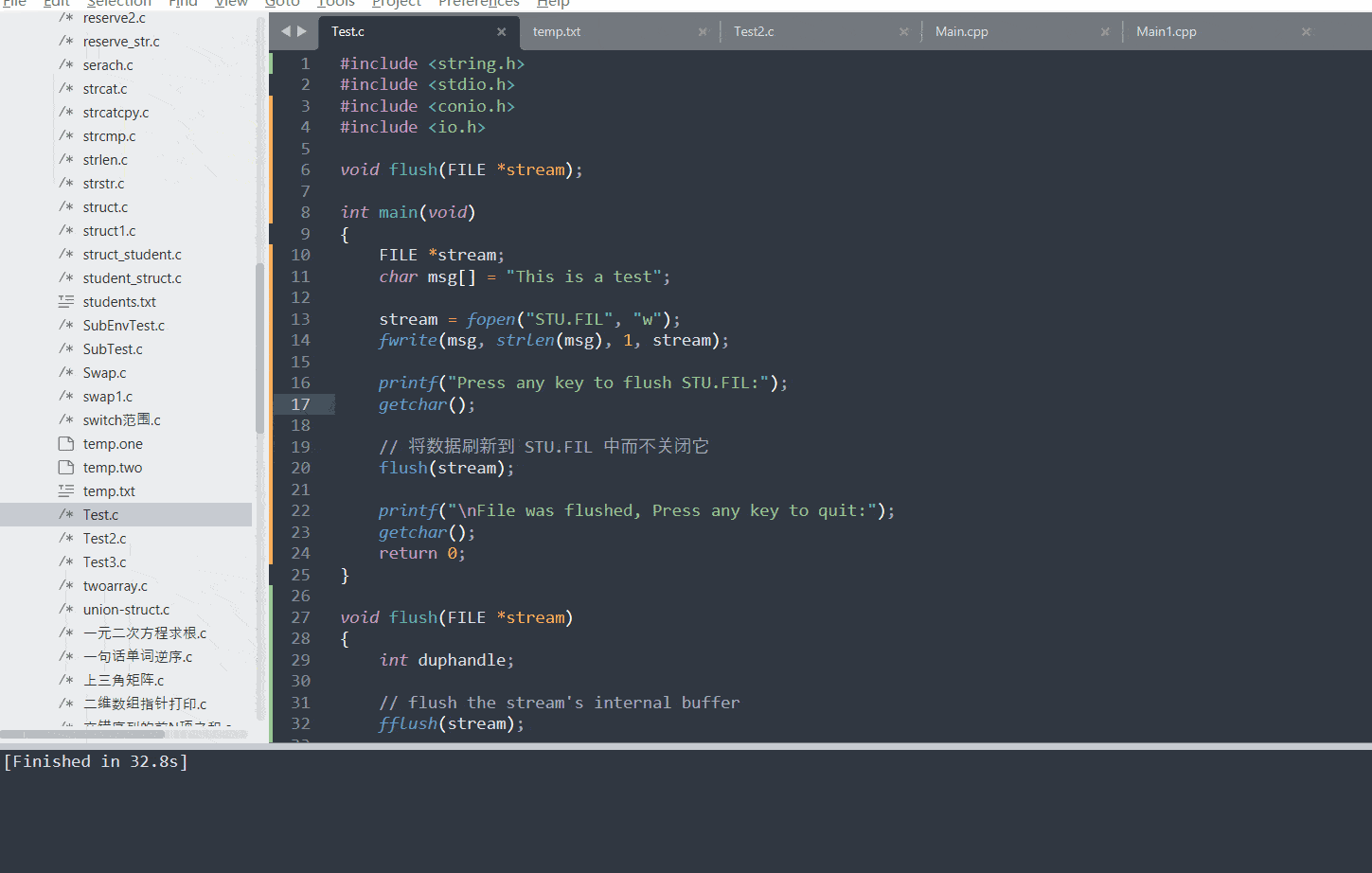
10. fgetc
10.1 函数说明
函数声明 | 函数功能 |
|---|---|
| 从流中读取字符 |
10.2 演示示例
#include <string.h>
#include <stdio.h>
int main(void)
{
FILE *stream;
char string[] = "This is a test";
char ch;
stream = fopen("STU.FIL", "w+");
fwrite(string, strlen(string), 1, stream);
fseek(stream, 0, SEEK_SET);
do
{
ch = fgetc(stream);
putchar(ch);
} while (ch != EOF);
fclose(stream);
return 0;
}10.3 运行结果
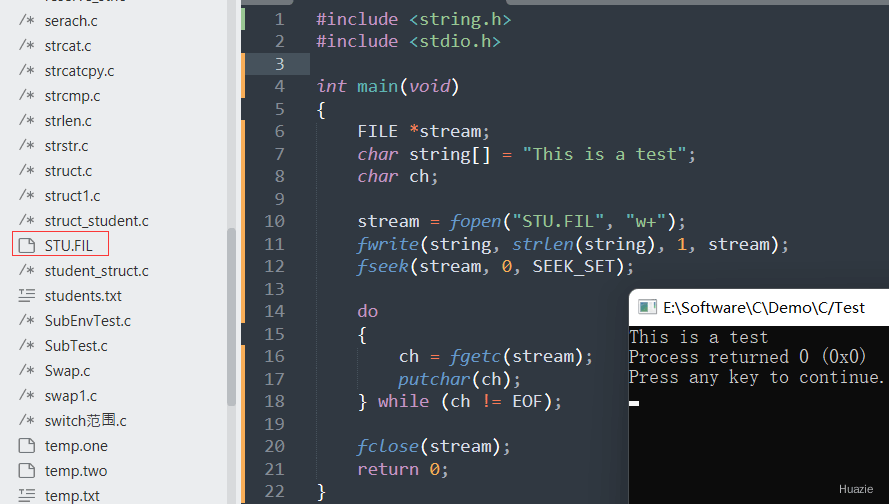
11. fgetchar
11.1 函数说明
函数声明 | 函数功能 |
|---|---|
| 从流中读取字符 |
11.2 演示示例
#include <stdio.h>
int main(void)
{
char ch;
printf("Enter a character followed by <Enter>: ");
// read the character from stdin
ch = fgetchar();
printf("The character read is: '%c'\n", ch);
return 0;
}11.3 运行结果
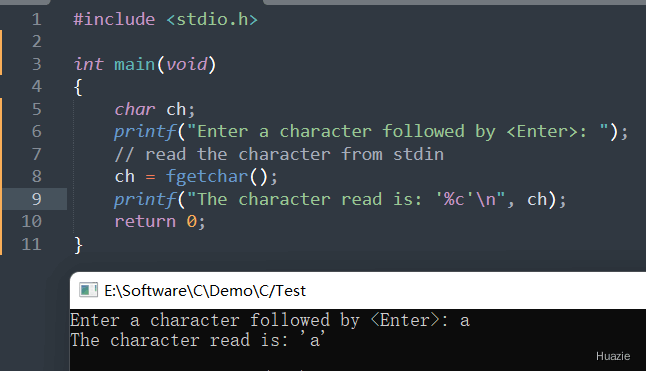
12. fgetpos
12.1 函数说明
函数声明 | 函数功能 |
|---|---|
| 依据当前文件的句柄,获取当前访问指针位置信息 |
12.2 演示示例
#include <string.h>
#include <stdio.h>
int main(void)
{
FILE *stream;
char string[] = "This is a test";
fpos_t filepos;
stream = fopen("STU.FIL", "w+");
fwrite(string, strlen(string), 1, stream);
// report the file pointer position
fgetpos(stream, &filepos);
printf("The file pointer is at byte %lld\n", filepos);
fclose(stream);
return 0;
}12.3 运行结果
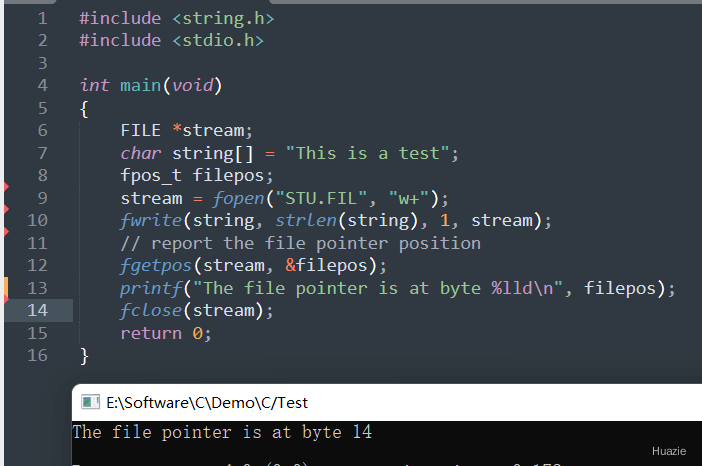
13. fgets
13.1 函数说明
函数声明 | 函数功能 |
|---|---|
| 从指定的流中读取数据,每次读取一行 |
参数:
- str : 这是指向一个字符数组的指针,该数组存储了要读取的字符串。
- n: 这是要读取的最大字符数(包括最后的空字符)。通常是使用以 str 传递的数组长度。
- stream: 这是指向 FILE 对象的指针,该 FILE 对象标识了要从中读取字符的流。
注意: 如果文件中的一行,不足 n-1 个字符,则读完该行就直接结束。如若该行(包括最后一个换行符)的字符数超过 n-1,则 fgets 只返回一个不完整的行,但是,缓冲区总是以 NULL 字符结尾,对 fgets 的下一次调用会继续读该行。函数成功将返回 stream,失败或读到文件结尾返回 NULL。因此不能直接通过 fgets 的返回值来判断函数是否是出错而终止的,应该借助 feof 函数或者 ferror 函数来判断。
13.2 演示示例
#include <string.h>
#include <stdio.h>
int main(void)
{
FILE *stream;
char str[] = "This is a test\n12344";
char msg[20];
stream = fopen("STU.FIL", "w+");
fwrite(str, strlen(str), 1, stream);
// seek to the start of the file
fseek(stream, 0, SEEK_SET);
while(!feof(stream))
{
fgets(msg, strlen(str) + 1, stream);
printf("%s", msg);
}
fclose(stream);
return 0;
}13.3 运行结果
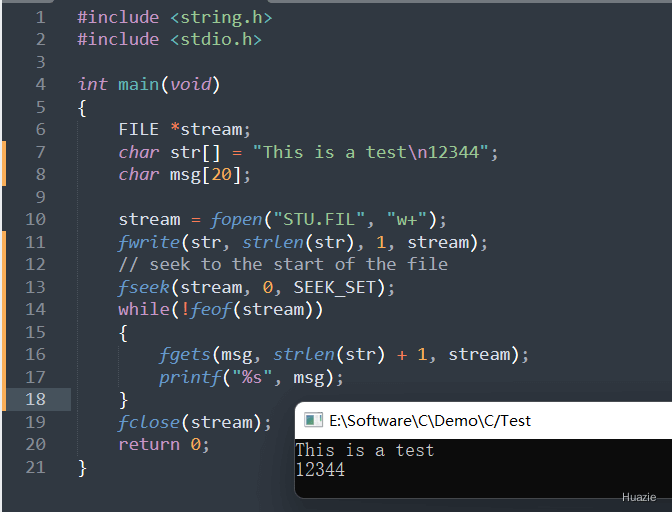

14. filelength
14.1 函数说明
函数声明 | 函数功能 |
|---|---|
| 获取文件的长度 |
14.2 演示示例
#include <stdio.h>
#include <fcntl.h>
#include <io.h>
int main(void)
{
int handle;
char buf[30] = "This is a test\n12344";
handle = open("STU.FIL", O_CREAT);
write(handle, buf, strlen(buf));
printf("file length in bytes: %ld\n", filelength(handle));
close(handle);
return 0;
}14.3 运行结果
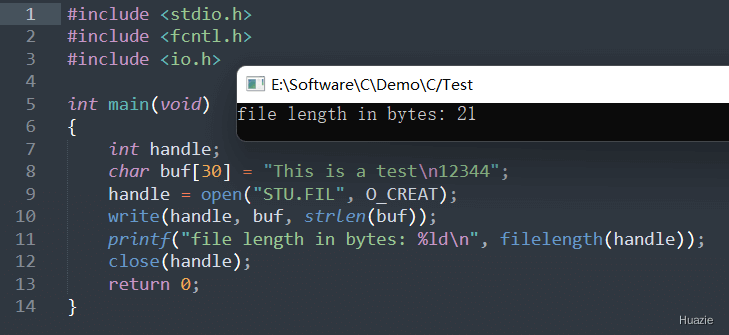
15. fileno
15.1 函数说明
函数声明 | 函数功能 |
|---|---|
| 获取参数stream指定的文件流所使用的文件描述符 |
15.2 演示示例
#include <stdio.h>
#include <fcntl.h>
#include <io.h>
int main(void)
{
FILE *stream;
char buf[30] = "This is a test\n12344";
stream = fopen("STU.FIL", "w+");
fwrite(buf, strlen(buf), 1, stream);
// 清除读写缓冲区,并将缓冲区内的数据写回参数stream指向的文件中。
fflush(stream);
// 获取参数stream指定的文件流所使用的文件描述符
int handle = fileno(stream);
printf("file length in bytes: %ld\n", filelength(handle));
fclose(stream);
return 0;
}15.3 运行结果
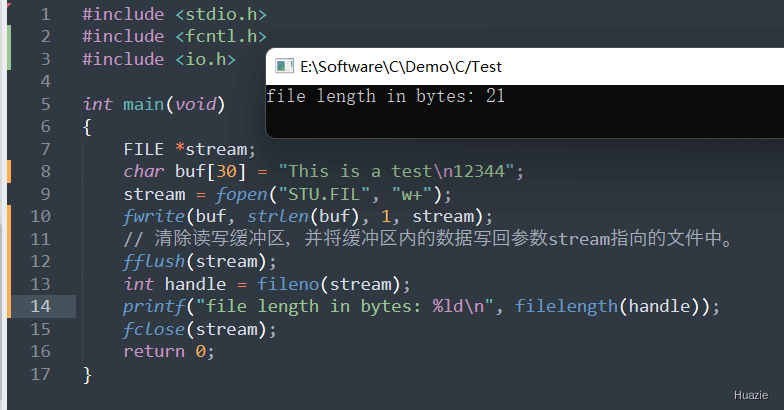
16. fillellipse
16.1 函数说明
函数声明 | 函数功能 |
|---|---|
| 画出并填充一椭圆 |
参数:
int x:椭圆中心点的x坐标。在二维图形环境中,x坐标通常表示水平方向上的位置,从左到右增加;int y:椭圆中心点的y坐标。在二维图形环境中,y坐标通常表示垂直方向上的位置,从上到下增加;int xradius:椭圆在x轴方向上的半径。它是从椭圆中心点到椭圆边缘在x轴方向上的最大距离。如果 xradius 较大,椭圆在水平方向上会显得更宽;int yradius:椭圆在y轴方向上的半径。它是从椭圆中心点到椭圆边缘在y轴方向上的最大距离。如果 yradius 较大,椭圆在垂直方向上会显得更高。
16.2 演示示例
#include <graphics.h>
int main(void)
{
int gdriver = DETECT, gmode;
int xcenter, ycenter, i;
initgraph(&gdriver,&gmode,"");
xcenter = getmaxx() / 2;
ycenter = getmaxy() / 2;
for (i=EMPTY_FILL; i<USER_FILL; i++)
{
cleardevice();
// 设置填充图样和颜色
setfillstyle(i, WHITE);
fillellipse(xcenter, ycenter, 100, 50);
getch();
}
closegraph();
return 0;
}16.3 运行结果
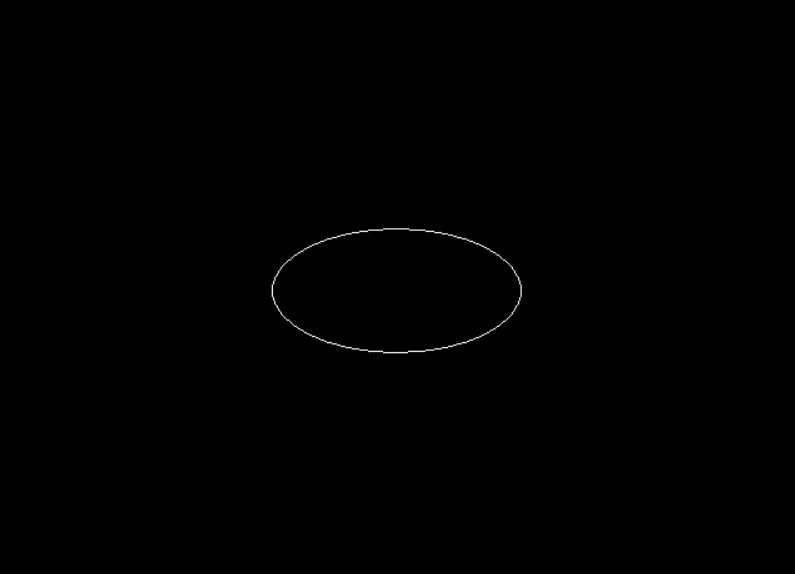
17. fillpoly
17.1 函数说明
函数声明 | 函数功能 |
|---|---|
| 画并填充一个多边形 |
参数:
numpoints: 多边形边数polypoints: 存储各顶点坐标的数组,每两个一组表示一个顶点的X,Y坐标
17.2 演示示例
#include <graphics.h>
#include <stdlib.h>
#include <stdio.h>
int main(void)
{
int gdriver = DETECT, gmode, errorcode;
int i, maxx, maxy;
int poly[8];
initgraph(&gdriver, &gmode, "");
errorcode = graphresult();
if (errorcode != grOk)
{
printf("Graphics error: %s\n", grapherrormsg(errorcode));
printf("Press any key to halt:");
getch();
exit(1);
}
maxx = getmaxx();
maxy = getmaxy();
poly[0] = 20;
poly[1] = maxy / 2;
poly[2] = maxx - 20;
poly[3] = 20;
poly[4] = maxx - 50;
poly[5] = maxy - 20;
poly[6] = maxx / 2;
poly[7] = maxy / 2;
for (i=EMPTY_FILL; i<USER_FILL; i++)
{
setfillstyle(i, getmaxcolor());
fillpoly(4, poly);
getch();
}
closegraph();
return 0;
}17.3 运行结果

18. findfirst, findnext
18.1 函数说明
函数声明 | 函数功能 |
|---|---|
| 搜索与指定的文件名称匹配的第一个文件,若成功则返回第一个文件的文件描述符,否则返回-1L。 |
| 搜索与_findfirst函数提供的文件名称匹配的下一个实例,若成功则返回0,否则返回-1 |
_findfirst 参数:
char *pathname:一个指向以null结尾的字符串的指针,该字符串指定了要搜索的文件名模式。文件名模式可以包含通配符,如*(匹配任意数量的字符)和?(匹配单个字符)。例如,"*.txt"会匹配所有以.txt为扩展名的文件。如果pathname字符串的最后一个字符是目录分隔符,那么函数将搜索该目录下的所有文件和子目录;如果pathname是一个空字符串,函数将搜索当前目录。struct _finddata_t *_FindData:一个指向_finddata_t结构体的指针,该结构体用于接收关于找到的文件的信息。_finddata_t结构体通常包含文件的属性(如是否只读、是否隐藏等)、创建时间、访问时间、修改时间、文件大小以及文件名等信息。调用_findfirst函数后,_FindData指向的结构体将被填充为与文件名模式匹配的第一个文件的信息。如果搜索成功,_findfirst函数将返回一个唯一的搜索句柄,这个句柄可以在后续的_findnext函数调用中使用,以查找与相同文件名模式匹配的其他文件。
_findnext 参数:
int handle:一个由_findfirst函数返回的搜索句柄。这个句柄标识了一个特定的文件搜索操作,该操作在调用_findfirst后开始。搜索句柄是一个唯一的标识符,用于后续调用_findnext来检索与原始搜索条件匹配的下一个文件或目录。struct _finddata_t *_FindData:同上_findfirst的参数
18.2 演示示例
#include<stdio.h>
#include<io.h>
int main()
{
int handle;
struct _finddata_t FileInfo;
// 搜索与指定的文件名称匹配的第一个文件,若成功则返回第一个文件的文件描述符,否则返回-1L。
if((handle=_findfirst("E:\\Pic\\*.png", &FileInfo))==-1L)
printf("没有找到匹配的项目\n");
else
{
printf("handle=%d\n", handle);
printf("%s\n\n", FileInfo.name);
// 搜索与_findfirst函数提供的文件名称匹配的下一个实例,若成功则返回0,否则返回-1
while(_findnext(handle, &FileInfo)==0)
printf("%s\n",FileInfo.name);
_findclose(handle);
}
return 0;
}18.3 运行结果
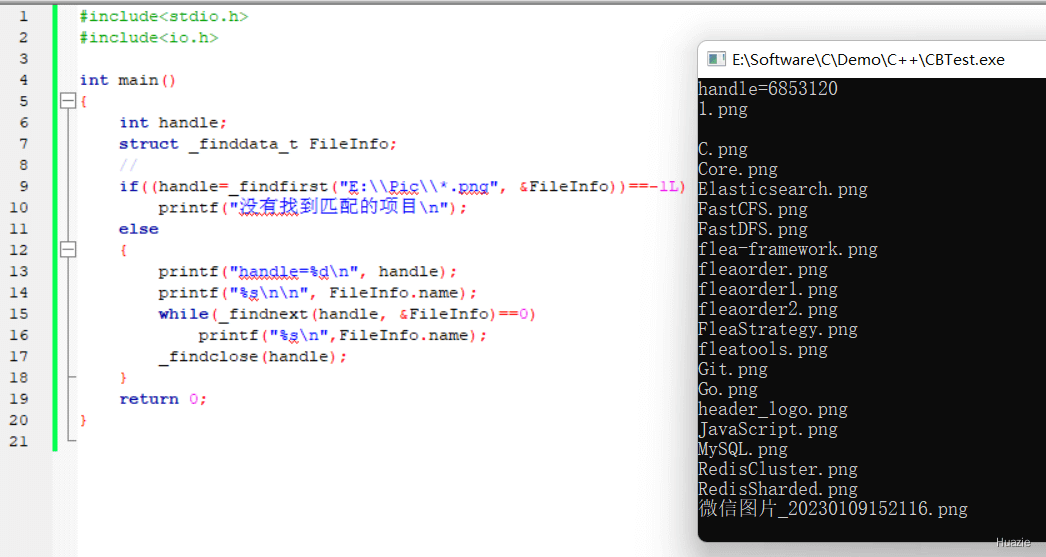
19. finite,finitef
19.1 函数说明
函数声明 | 函数功能 |
|---|---|
| 检查 x 是无穷大值还是NaN 值(double)。如果是无穷大值或NaN值,返回 0;否则返回 1。 |
| 检查 x 是无穷大值还是NaN 值(float)。如果是无穷大值或NaN值,返回 0;否则返回 1。 |
19.2 演示示例
#include<stdio.h>
#include<math.h>
int main()
{
double x = NAN, y = INFINITY, z = 10.24;
printf("finite(%.2lf) = %d\n", x, finite(x));
printf("finite(%.2lf) = %d\n", y, finite(y));
printf("finite(%.2lf) = %d\n", z, finite(z));
float xf = NAN, yf = INFINITY, zf = 5.63;
printf("\nfinitef(%.2f) = %d\n", xf, finitef(xf));
printf("finitef(%.2f) = %d\n", yf, finitef(yf));
printf("finitef(%.2f) = %d\n", zf, finitef(zf));
return 0;
}19.3 运行结果
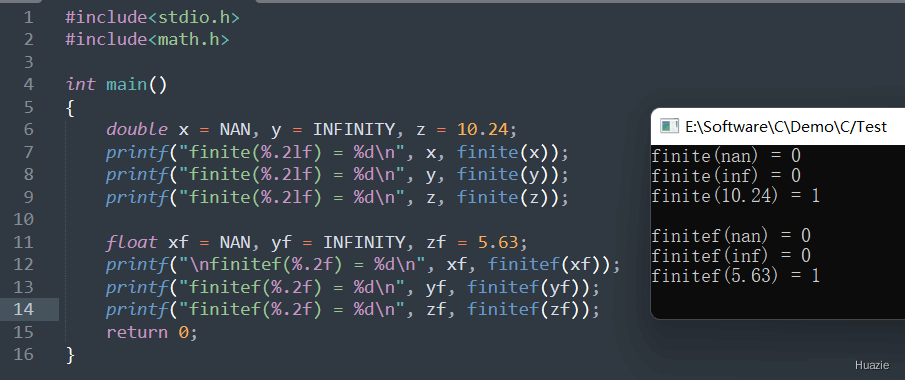
20. floodfill
20.1 函数说明
函数声明 | 函数功能 |
|---|---|
| 填充一个有界区域 |
参数:
int x:要开始填充的区域的起始点的 x 坐标;int y:要开始填充的区域的起始点的 y 坐标;int border:填充的边界颜色。泛洪填充算法会从起始点 (x, y) 开始,将所有相邻的、颜色与起始点相同的区域填充为新的颜色,直到遇到边界颜色 border 为止。这样,算法就不会越过由 border 颜色定义的边界,从而保证了填充区域的准确性。
20.2 演示示例
#include <graphics.h>
#include <stdlib.h>
#include <stdio.h>
int main(void)
{
int gdriver = DETECT, gmode, errorcode;
int maxx, maxy;
initgraph(&gdriver, &gmode, "");
errorcode = graphresult();
if (errorcode != grOk)
{
printf("Graphics error: %s\n", grapherrormsg(errorcode));
printf("Press any key to halt:");
getch();
exit(1);
}
maxx = getmaxx();
maxy = getmaxy();
// select drawing color
setcolor(getmaxcolor());
// select fill color
setfillstyle(SOLID_FILL, getmaxcolor());
// draw a border around the screen
rectangle(0, 0, maxx, maxy);
// draw some circles
circle(maxx / 3, maxy /2, 50);
circle(maxx / 2, 20, 100);
circle(maxx-20, maxy-50, 75);
circle(20, maxy-20, 25);
getch();
// fill in bounded region
floodfill(2, 2, getmaxcolor());
getch();
closegraph();
return 0;
}20.3 运行结果

参考
原创声明:本文系作者授权腾讯云开发者社区发表,未经许可,不得转载。
如有侵权,请联系 cloudcommunity@tencent.com 删除。
原创声明:本文系作者授权腾讯云开发者社区发表,未经许可,不得转载。
如有侵权,请联系 cloudcommunity@tencent.com 删除。

